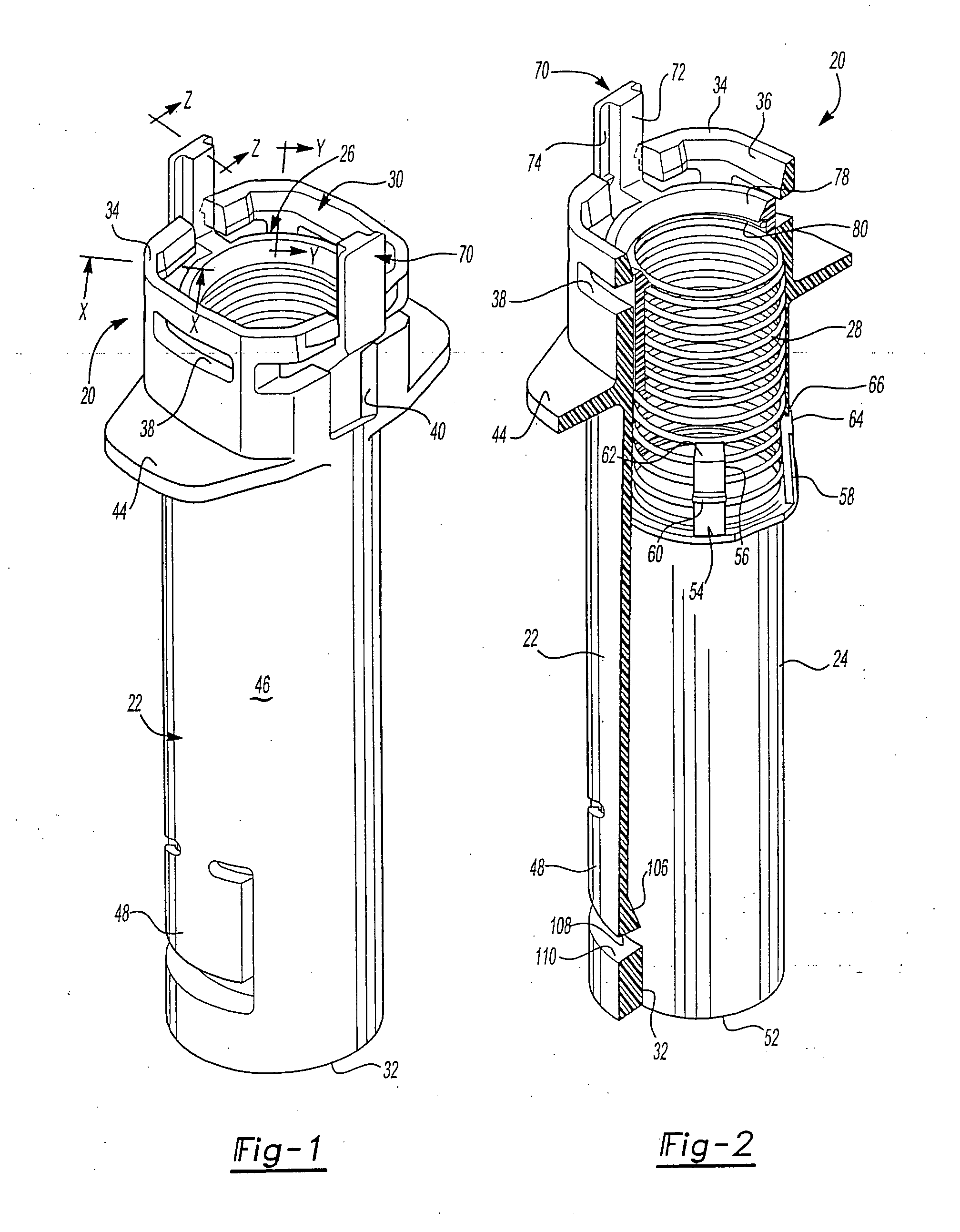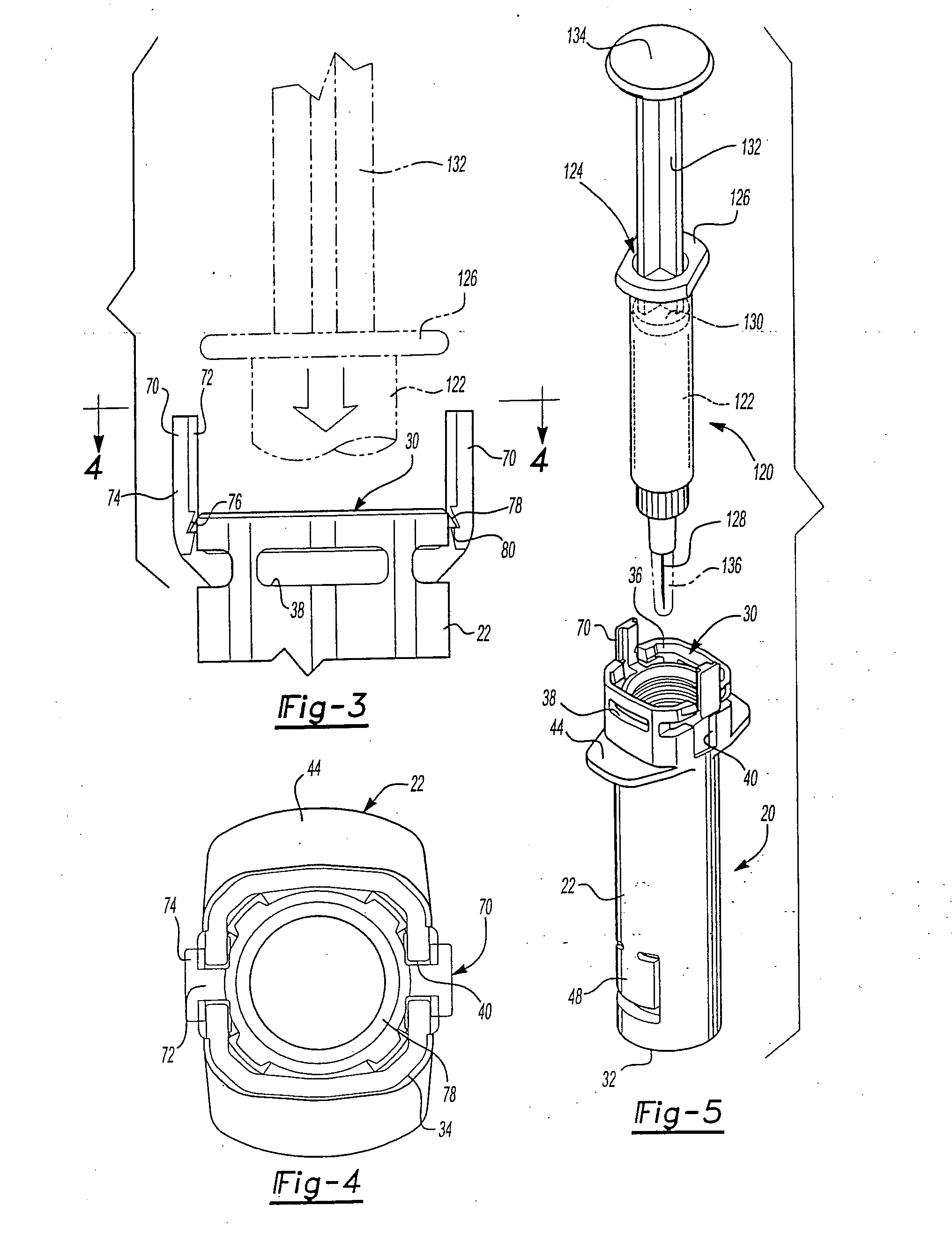[0010] As set forth above, the
safety shield system of this invention is passive, but avoids the problems associated with the prior art passive shield systems. The shield system of this invention may be utilized with prefilled syringes of the type described above, but may also be used with other types of injection devices. Premature or inadvertent actuation of the shield system is minimized by an
interlock system which allows packing, transportation in bulk and high speed feeding systems in bowls, etc. Further, the needle cover or shield is moved to enclose the needle cannula by release of the plunger, thereby giving the user the option of releasing the needle cover only after complete delivery of the fluid in the syringe and removal of the needle cannula from the patient, while assuring shielding of the
syringe needle cannula prior to disposal.
[0011] The disclosed embodiment of the passive shield system of this invention includes four components, namely a generally tubular body having an open proximal end for
receipt of a syringe, a generally tubular shield or needle cover telescopically supported by the body and extendable from a retracted position, wherein the
syringe needle cannula is exposed, to an extended position enclosing the needle, a spring biasing the shield toward the extended position, and an annular or ring shaped member which interlocks with the body to prevent premature actuation of the shield or needle cover and which actuates the shield upon release of the plunger following complete delivery of the substance in the syringe. In the disclosed embodiment of the shield system of this invention, the needle cover or shield is telescopically received within the body and moveable axially to shield the needle cannula of the syringe as described. The spring and the ring shaped member are received in the open proximal end of the body such that the spring is biased between the ring shaped member and the shield. Prior to
receipt of the syringe, the ring shaped member serves as a locking member preventing premature actuation of the shield. The ring shaped member or locking member includes a leg which forms a mechanical
interlock with the body. In the disclosed embodiment, the ring shaped member includes two opposed axially extending legs which, in the preferred embodiment, extend proximally, preferably beyond the open end of the body, for actuation of the shield as described below. In the disclosed embodiment, the legs include opposed V-shaped locking surfaces which form a mechanical interlock with an opposed surface of the body adjacent the open proximal end preventing inadvertent or premature actuation of the shield during bulk shipping and processing as described above. In one disclosed embodiment, the projecting legs of the ring shaped locking member are partially enclosed or surrounded by walls which minimize inadvertent release of the shield by the user. Upon loading of a syringe in the open proximal open end of the shield system, the syringe
flange engages the proximal end of the ring shaped member, driving the ring shaped member distally and the legs of the ring shaped member releasing the interlock between the ring shaped member or locking member and the body for actuation of the shield as now described.
[0014] The shield is thus actuated in stages, as follows. First, as the injection is made, the
thumb pad of the plunger
assembly of the syringe engages the proximally extending legs of the ring shaped member, driving the ring shaped member distally in the body. The first camming surfaces of the ring shaped member opposite the first pair of fingers then releases the first pair of fingers and the shield moves axially to a second retracted position because the second biasing or camming surfaces of the ring shaped member opposite the second pair of fingers simultaneously biases the second pair of fingers radially outwardly to receive the radial surfaces on the opposed radial surfaces or ledges of the body, releasably retaining the shield in a second retracted position. In the preferred embodiment, the second retracted position is close to or adjacent the first retracted position of the shield. Then, upon completion of the injection and release of the plunger by the user, the spring biases the ring shaped member proximally, releasing the second pair of fingers, and the shield is then driven distally to shield the needle as described. In the preferred embodiment, the body further includes opposed detents adjacent the distal end of the body which receive a radial portion or annular rib of the shield adjacent its proximal end which prevents retraction of the shield following actuation. The shield system of this invention is thus passive in the sense that an additional action by the user is not required to activate the shield. That is, the shield is automatically activated upon release of the plunger. However, the user can also select the timing of the actuation of the shield, for example, by releasing the plunger after removal of the needle cannula from the patient, thereby eliminating engagement of the needle shield against the
skin of the patient. Further, upon release of the syringe plunger by the user, the spring drives the shield from its second retracted position to its extended position, enclosing the
syringe needle cannula, rather than retracting the syringe into the shield as disclosed in the prior art. Another
advantage of the shield system of this invention is that it may be used with conventional syringes without requiring special plungers,
thumb pads, etc. A further
advantage is that the shield system of this invention may be designed for different sizes of syringes.
 Login to View More
Login to View More 


